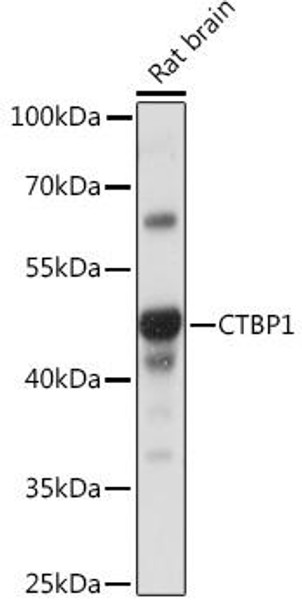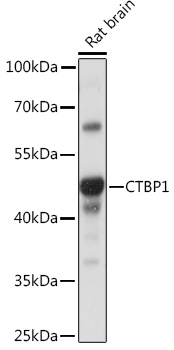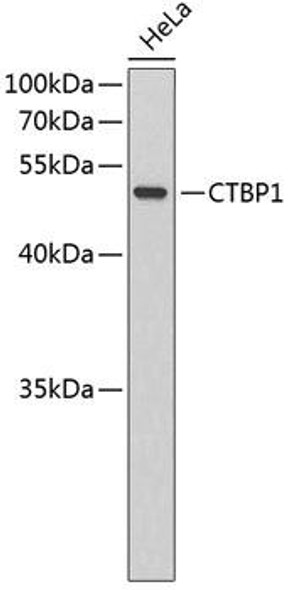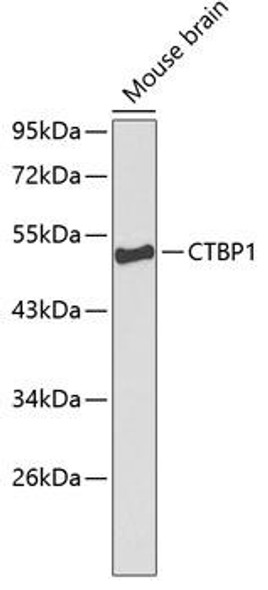Developmental Biology
Anti-CTBP1 Antibody (CAB16825)
- SKU:
- CAB16825
- Product Type:
- Antibody
- Reactivity:
- Human
- Reactivity:
- Mouse
- Reactivity:
- Rat
- Host Species:
- Rabbit
- Isotype:
- IgG
- Antibody Type:
- Polyclonal Antibody
- Research Area:
- Developmental Biology
Description
| Antibody Name: | Anti-CTBP1 Antibody |
| Antibody SKU: | CAB16825 |
| Antibody Size: | 20uL, 50uL, 100uL |
| Application: | WB |
| Reactivity: | Human, Mouse, Rat |
| Host Species: | Rabbit |
| Immunogen: | Recombinant fusion protein containing a sequence corresponding to amino acids 20-250 of human CTBP1 (NP_001319.1). |
| Application: | WB |
| Recommended Dilution: | WB 1:500 - 1:2000 |
| Reactivity: | Human, Mouse, Rat |
| Positive Samples: | Rat brain |
| Immunogen: | Recombinant fusion protein containing a sequence corresponding to amino acids 20-250 of human CTBP1 (NP_001319.1). |
| Purification Method: | Affinity purification |
| Storage Buffer: | Store at -20°C. Avoid freeze / thaw cycles. Buffer: PBS with 0.02% sodium azide, 50% glycerol, pH7.3. |
| Isotype: | IgG |
| Sequence: | MNGP LHPR PLVA LLDG RDCT VEMP ILKD VATV AFCD AQST QEIH EKVL NEAV GALM YHTI TLTR EDLE KFKA LRII VRIG SGFD NIDI KSAG DLGI AVCN VPAA SVEE TADS TLCH ILNL YRRA TWLH QALR EGTR VQSV EQIR EVAS GAAR IRGE TLGI IGLG RVGQ AVAL RAKA FGFN VLFY DPYL SDGV ERAL GLQR VSTL QDLL FHSD CVTL HCGL NEHN HHLI NDF |
| Gene ID: | 1487 |
| Uniprot: | Q13363 |
| Cellular Location: | Cytoplasm, Nucleus |
| Calculated MW: | 46kDa/47kDa |
| Observed MW: | 47kDa |
| Synonyms: | CTBP1, BARS |
| Background: | This gene encodes a protein that binds to the C-terminus of adenovirus E1A proteins. This phosphoprotein is a transcriptional repressor and may play a role during cellular proliferation. This protein and the product of a second closely related gene, CTBP2, can dimerize. Both proteins can also interact with a polycomb group protein complex which participates in regulation of gene expression during development. Alternative splicing of transcripts from this gene results in multiple transcript variants. |
| UniProt Protein Function: | CTBP1: Involved in controlling the equilibrium between tubular and stacked structures in the Golgi complex. Functions in brown adipose tissue (BAT) differentiation. Corepressor targeting diverse transcription regulators such as GLIS2. Has dehydrogenase activity. Homo- or heterodimer. Heterodimer with CTBP2. Interacts with PRDM16; the interaction represses white adipose tissue (WAT)- specific genes expression. Interacts with GLIS2, FOXP2, HDAC4, HDAC5, HDAC9 and ZNF217. Interacts with adenovirus E1A protein (via its C-terminus); the interaction disrupts the interaction of CTBP1 with RBBP8. Interacts with Epstein-Barr virus EBNA3 and EBNA6. Interacts with ELK3 (via its PXDLS motif). Interacts with RBBP8 (via its PXDLS motif); the interaction is disrupted by binding to adenovirus E1A. Interacts with FOXP1, HIPK2, PNN, NRIP1, MECOM, ZNF366, ZFHX1B and WIZ. Interaction with SATB1 (non-acetylated form); the interaction stabilizes its attachment to DNA and promotes transcription repression. Belongs to the D-isomer specific 2-hydroxyacid dehydrogenase family. 2 isoforms of the human protein are produced by alternative splicing. |
| UniProt Protein Details: | Protein type:Oxidoreductase; Nuclear receptor co-regulator; EC 1.1.1.-; Transcription, coactivator/corepressor; Cell cycle regulation Chromosomal Location of Human Ortholog: 4p16 Cellular Component: nucleoplasm; transcription factor complex; transcriptional repressor complex; cytosol; nucleus Molecular Function:protein C-terminus binding; protein domain specific binding; protein binding; protein homodimerization activity; transcription factor binding; NAD binding; transcription factor activity; oxidoreductase activity, acting on the CH-OH group of donors, NAD or NADP as acceptor Biological Process: negative regulation of cell proliferation; positive regulation of histone deacetylation; transcription, DNA-dependent; regulation of cell cycle; white fat cell differentiation; viral genome replication; negative regulation of transcription from RNA polymerase II promoter; negative regulation of transcription, DNA-dependent; Golgi organization and biogenesis; protein amino acid phosphorylation; negative regulation of histone acetylation Disease: Wolf-hirschhorn Syndrome |
| NCBI Summary: | This gene encodes a protein that binds to the C-terminus of adenovirus E1A proteins. This phosphoprotein is a transcriptional repressor and may play a role during cellular proliferation. This protein and the product of a second closely related gene, CTBP2, can dimerize. Both proteins can also interact with a polycomb group protein complex which participates in regulation of gene expression during development. Alternative splicing of transcripts from this gene results in multiple transcript variants. [provided by RefSeq, Jul 2008] |
| UniProt Code: | Q13363 |
| NCBI GenInfo Identifier: | 6014741 |
| NCBI Gene ID: | 1487 |
| NCBI Accession: | Q13363.2 |
| UniProt Secondary Accession: | Q13363,Q4W5N3, Q7Z2Q5, |
| UniProt Related Accession: | Q13363 |
| Molecular Weight: | 440 |
| NCBI Full Name: | C-terminal-binding protein 1 |
| NCBI Synonym Full Names: | C-terminal binding protein 1 |
| NCBI Official Symbol: | CTBP1 |
| NCBI Official Synonym Symbols: | BARS |
| NCBI Protein Information: | C-terminal-binding protein 1; brefeldin A-ribosylated substrate |
| UniProt Protein Name: | C-terminal-binding protein 1 |
| UniProt Gene Name: | CTBP1 |
| UniProt Entry Name: | CTBP1_HUMAN |







![CTBP1 Monoclonal Antibody [AT4D6] (CPAB0441) CTBP1 Monoclonal Antibody [AT4D6] (CPAB0441)](https://cdn11.bigcommerce.com/s-rd6ounxcu2/images/stencil/590x590/products/58663/63845/ctbp1-monoclonal-antibody-at4d6-cpab0441__53418__27942.1706535175.jpg?c=1)